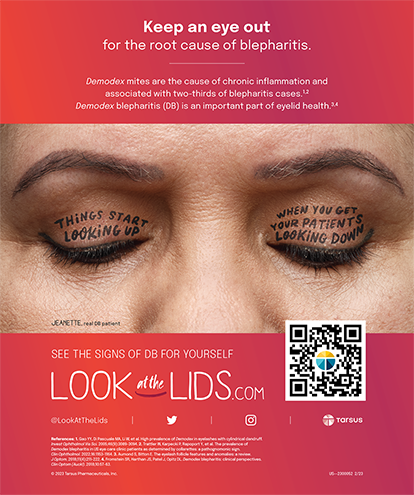The surefire way to satisfying patients is ensuring that their surgical results exceed their expectations. For individuals seeking presbyopic correction at the time of cataract surgery, success means enabling them to see without glasses for as many activities as possible. Diffractive multifocal IOLs consistently offer both a distance and a near focal point to most patients.
The current presbyopia-correcting IOLs provide excellent outcomes to appropriately selected recipients if the postoperative refraction is close to plano for both sphere and cylinder. I continue to offer the full spectrum of these lenses, including multifocal and accommodating designs, because no IOL is perfect for everyone. Patients should understand that no man-made technology performs as well as young, human eyes. The new generation of presbyopia-correcting lens implants, however, can give many patients better vision than they have had in decades.
PATIENT SELECTION
The ideal candidates for multifocal IOLs are hyperopic, with minimal-to-mild degrees of astigmatism and a healthy ocular surface and posterior segment. Before cataract surgery, these patients wear their spectacles full time. Successful surgery with a diffractive multifocal IOL can give them spectacle independence for most activities. For individuals with anticipated residual astigmatism, an irregular ocular surface, or retinal pathology, multifocal IOLs are generally contraindicated.
FEATURES OF THE TECNIS
The Tecnis Multifocal IOL (Abbott Medical Optics Inc., Santa Ana, CA) has an aspheric anterior surface with a fully diffractive posterior surface that provides a +4.00 D add at the IOL plane and an approximately +3.00 D add at the spectacle plane. Using the formula that focal length = 1/power of the lens in diopters, the IOL gives an optimal near reading point of approximately 33 cm or 13 inches. The implant’s significant depth of field around this point provides patients with a larger functional range of vision than just the exact focal point, including at intermediate distances.
The Tecnis Multifocal IOL has diffractive rings along the entire optic, which tend to split light evenly between near and far focal points at all pupillary sizes. This design can help them to read in dim light. The pupil’s size and ambient lighting play roles in depth of field, however, and affect the patient’s ability to see at a variety of working distances. Although 94% of patients in the IOL’s FDA trial were able to function comfortably without glasses at all distances, it is important for patients to understand that they may need to wear glasses for some activities.1
IOL POWER CALCULATIONS AND REFRACTIVE CONSIDERATIONS
I have obtained the most accurate results using the Holladay 2 formula, which is available as part of the Holladay IOL Consultant & Surgical Outcomes Analysis Program (Holladay Consulting, Inc., Bellaire, TX) combined with noncontact optical biometry. The recommended A-constant for the new Tecnis Multifocal One-Piece (model ZMB00U) IOL is 119.4, when it is placed in the capsular bag. I prefer to choose a postoperative target just slightly on the hyperopic side of plano (ie, up to +0.25 D) to keep the near point at a reasonable range. A myopic postoperative refraction of -0.50 D will degrade the clarity of distance vision but will bring the effective add of the near point to approximately +3.50 D, which is too strong for most patients.
Corneal astigmatism must be addressed at the time of surgery so that the residual cylinder is 0.50 D or less. My technique of choice for astigmatic correction in these patients is a limbal relaxing incision performed with a diamond blade. I am able to reliably correct up to 1.50 D of corneal astigmatism with incisional techniques. For patients with larger degrees of astigmatism, I can pair the cataract surgery with LASIK or PRK to fine-tune the refractive result.
CAPSULORHEXIS AND MULTIFOCALITY
The capsulorhexis should be about 5.0 to 5.5 mm in diameter so that the optic is fully overlapped by the anterior capsular rim. This ensures stability of the IOL and gives a consistent effective lens position, which is crucial in achieving the desired postoperative refractive goal. I like to orient the lens at the 12- and 6-o’clock meridians in order to shift the optic nasally to align it with the pupil and move it closer to the patient’s visual axis. It is important to remember that the center of the capsular bag and the center of the cornea do not typically line up with the center of the pupil or visual axis, both of which tend to be nasally displaced.
With multifocality, patients are able to see both near and far without glasses in the immediate postoperative period. They may need time to adjust to their new vision, however, particularly in situations such as when viewing bright lights against a dark night sky. Side effects such as glare and halo tend to be exaggerated in eyes with residual refractive error, so I make every effort to fine-tune the refraction. The ocular surface and tear film should also be optimized, because the first refracting element of the eye is the air-to-tear interface.
CONCLUSION
Safe, efficient, and precise phacoemulsification has made cataract surgery one of the best refractive procedures available. In one procedure, ophthalmologists can correct cataract, hyperopia or myopia, astigmatism, and even presbyopia. Because it provides patients with a high degree of freedom from spectacles, the Tecnis Multifocal IOL is an appropriate choice for many individuals seeking presbyopic correction during cataract surgery (Figures 1 through 3). My clinical experience has been very positive, particularly among hyperopic patients. I encourage surgeons to add this lens to their offerings.
Note: HICSOAP, the Holladay IOL Consultant & Surgical Outcomes Analysis Program, is available from www.hicsoap.com.
Uday Devgan, MD, is in private practice at Devgan Eye Surgery in Los Angeles, Beverly Hills, and Newport Beach, California. He is a consultant to Abbott Medical Optics Inc. but acknowledged no direct financial interest in the products or other company mentioned herein. Dr. Devgan may be reached at (800) 337-1969; devgan@gmail.com.
- Tecnis Multifocal IOL [package insert].Santa Ana,CA:Abbott Medical Optics Inc.;2010.


